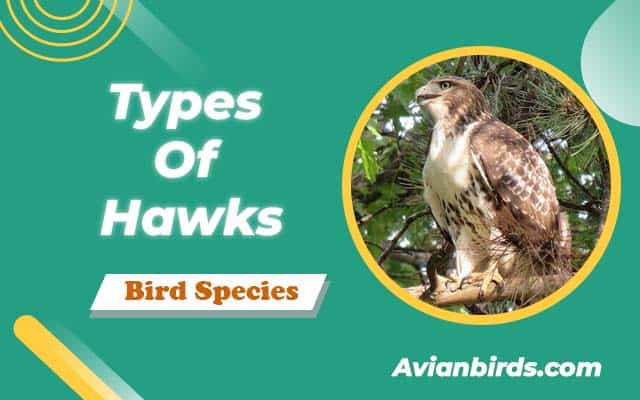9 Types of Hawks in Colorado (ID Guide With Pictures)
Do you know Colorado has 9 different types of Hawks? Let’s explore the skies of Colorado together. We’ll discover nine key hawk species in our state. This guide helps birdwatchers of all levels to better spot hawks with tips and pictures.
Colorado’s landscape, from plains to mountains, is home to a wide range of birds. It’s a great place for bird lovers to see these amazing creatures. We’ll learn about each hawk’s special traits, where they live, and how they behave.
This journey invites us to enjoy the beauty of nature. Let’s learn more about these incredible hawks and the wonders they bring to our world.
Introduction to Colorado’s Hawks
Colorado is home to many hawks, showing the rich bird life here. The state’s varied landscapes, from wide prairies to Rocky Mountain peaks, are perfect for hawks. Knowing about Colorado’s hawks helps us appreciate these amazing birds more.
Hawks are top predators, keeping the balance in nature. They help control the numbers of smaller animals.
Overview of Hawk Diversity
Many hawk species live in Colorado, with the Red-tailed Hawk being the most common. This shows Colorado’s dedication to protecting nature. Sometimes, we see the Red-Shouldered Hawk, known for its rust-colored patches and love for forests.
Birdwatchers can see hawks at places like Dinosaur Ridge Hawkwatch. It’s a great spot to watch them, especially during migration.
With help from Hawkwatch International and Colorado Parks & Wildlife, we learn more about Colorado’s hawks. Each hawk species adds to the state’s rich biodiversity. By loving these birds, we help keep Colorado’s wildlife beautiful and healthy.
Types of Hawks in Colorado
In Colorado, we find many types of hawks living in different places. Knowing where they live helps us enjoy watching birds more. Each hawk has its own favorite spot in the state.
Common Habitats
Hawks in Colorado live in many places. This makes them easy to see. Here are some common places:
- Forests: Sharp-shinned Hawks like forests. They hunt small birds there.
- Open Plains: Red-tailed Hawks and Swainson’s Hawks live on the plains. They use their sharp eyes to find food.
- Wetlands and Marshes: Northern Harriers live in wet areas. They hunt small animals and birds.
- Mountain Ridges: Golden Eagles like the mountains. They nest and hunt there.
1. Red-Tailed Hawk
- Scientific Name: Buteo jamaicensis
- Size: 18-26 inches
- Weight: 1.5-3.5 pounds
- Lifespan: 10-15 years
- Diet: Small mammals, birds, reptiles
- Call: Raspy “keeeeer”
- Speed: 20-40 mph (up to 120 mph in a dive)
The red-tailed hawk, known as Buteo jamaicensis, is a standout in Colorado. Its unique features make it a great example of hawk identification in the state.
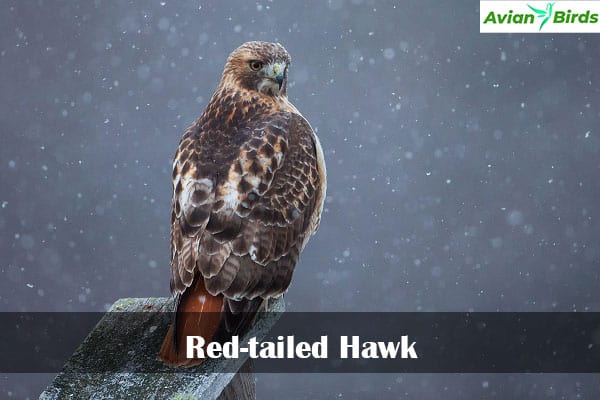
Identification Features
The red-tailed hawk’s reddish tail is its most noticeable feature. It also has a brown back and pale belly. Adults are 19.7 to 25.6 inches tall, with a wingspan of up to 52.4 inches.
Their wings are long and wide, perfect for soaring. We often see them gliding overhead. Dark leading edges on their wings help identify them.
- Dark markings on the lighter breast create a “belly band,” helping us identify them.
- Their “V” wing position and “flap, flap, glide” wingbeat pattern are signs of this species.
- Young hawks have a brown, banded tail. It turns cinnamon-red as it matures.
Habitat and Behavior
Red-tailed hawks live in many places in Colorado parks. They like open fields and forests. We often see them on telephone poles or trees, watching for prey.
They mostly eat rodents but also birds, rabbits, and snakes. These hawks are good partners and form long-term bonds.
They show their love through sky dancing in February and March. Their nests are in tall trees made of twigs and leaves. They lay one to four eggs in April or May.
These hawks have amazing eyesight, eight times stronger than ours. They spot food from far away. Seeing them in places like Rocky Mountain National Park is exciting for nature lovers.
2. Cooper’s Hawk
- Scientific Name: Accipiter cooperii
- Size: 14-20 inches
- Weight: 0.75-1.5 pounds
- Lifespan: 12 years (up to 20 years in captivity)
- Diet: Mainly small to medium-sized birds, also mammals and reptiles
- Call: Sharp “kik-kik-kik”
- Speed: 30-50 mph (up to 60 mph in pursuit)
The Cooper’s Hawk, known as Accipiter cooperii, is a bird of prey in our area. It has unique features and is very active. This makes it a favorite among bird watchers.
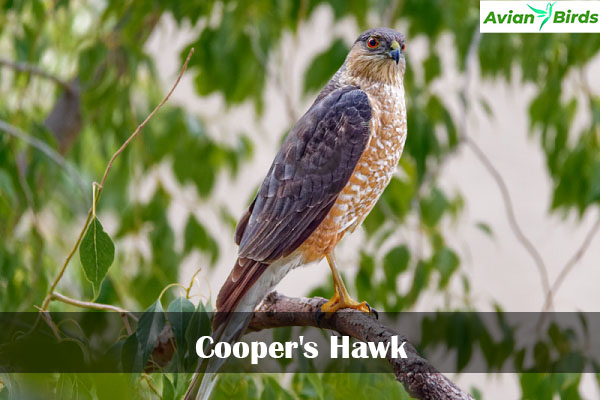
Distinctive Appearance
Adult Cooper’s Hawks have blue-gray upperparts with reddish bars on their chests. Their long, dark tails stand out. They are 14.6 to 15.3 inches long and have a wingspan of 24.4 to 35.4 inches.
In Colorado, we see smaller Cooper’s Hawks. They weigh up to one-fifth less than those in the east.
Feeding Habits
These hawks mainly eat medium-sized birds, earning them the nickname “chicken hawks.” Their diet includes woodpeckers, doves, and robins. They eat about 12 percent of their body weight each day, which is like four or five pizzas for a person.
They are great at hunting in dense forests and even at backyard feeders. During breeding, they lay three to five eggs. The eggs hatch after 30 to 36 days of incubation.
They can have two to four fledglings. Their ability to adapt shows their importance in our ecosystems.
3. Sharp-Shinned Hawk
- Scientific Name: Accipiter striatus
- Size: 9-13 inches
- Weight: 3-8 ounces
- Lifespan: 3-5 years (up to 13 years in the wild)
- Diet: Small birds, occasionally small mammals, insects
- Call: High-pitched “kik-kik-kik”
- Speed: 20-30 mph (up to 60 mph in pursuit)
The sharp-shinned hawk is a unique bird in Colorado. It has special features that make it stand out. Knowing its size and look helps birdwatchers identify it.

Size and Appearance
The sharp-shinned hawk is the smallest Accipiter in North America. It is 9.4 to 13.4 inches long. Its wingspan is 16.9 to 22.1 inches.
Its blue-gray upperparts and red-orange breast bars are eye-catching. Young hawks are brown with yellow eyes. Adults have white underparts.
One way to tell it’s a sharp-shinned hawk is its tail. It’s squared-off, unlike the Cooper’s hawk’s rounded tail.
Dietary Preferences
Sharp-skinned hawks mainly eat small birds. They also hunt small mammals outside of breeding season. They live in forests and sometimes visit bird feeders.
Plus, They are hard to spot because of their hunting skills. Knowing how they hunt helps them see them in the wild.
| Characteristic | Adult Northern | Immature Northern | Adult White-Breasted | Immature White-Breasted |
|---|---|---|---|---|
| Coloration | Blue-gray upperparts, red-orange breast bars | Brown overall, thick streaks below | Unmarked white underparts, gray crown | Rusty streaks and spots on underparts |
| Eye Color | Red | Yellow | Red | Yellow |
| Wing Shape | Narrow, small head | Narrow, small head | Narrow, small head | Narrow, small head |
4. Broad-Winged Hawk
- Scientific Name: Buteo platypterus
- Size: 13-17 inches
- Weight: 9-20 ounces
- Lifespan: 12-16 years
- Diet: Small mammals, amphibians, reptiles, insects
- Call: High-pitched whistle “kee-eee”
- Speed: 20-30 mph (up to 55 mph in a dive)
The broad-winged hawk, known as Buteo platypterus, is a fascinating bird. It has unique nesting habits and a striking look. These birds are 13.4 to 17.3 inches long and come in many colors.
Related: Owls in Colorado
Adults have reddish-brown heads, while young ones are lighter. They build nests in tall trees from April to August. These nests are in big forests.
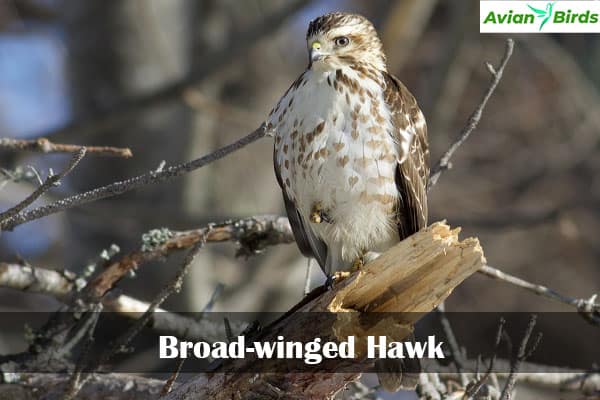
Nesting Behavior
Broad-winged hawks lay one to four eggs at a time. The eggs hatch after 28 days. The young birds need a lot of care for about 5 to 6 weeks.
Adults fight off raccoons and crows to protect their babies. This is during the nesting season.
When they migrate, these hawks fly in huge groups. They can travel 3,000 to 6,000 km, flying 100 km a day. They use coastlines and mountains to soar, using wind currents to help them.
Watching them nest and migrate is amazing. It shows how incredible their life cycle is.
5. Rough-legged Hawk
- Size: 18-24 inches
- Weight: 1.5-3.25 pounds
- Lifespan: 10-15 years
- Diet: Small mammals, primarily lemmings and voles
- Call: High-pitched, whistling scream
- Speed: 20-40 mph (up to 60 mph in a dive)
The Rough-Legged Hawk is a bird of prey seen in Colorado in winter. It has feathers on its legs to keep warm in cold weather. Learning about its migration makes us appreciate this bird more.
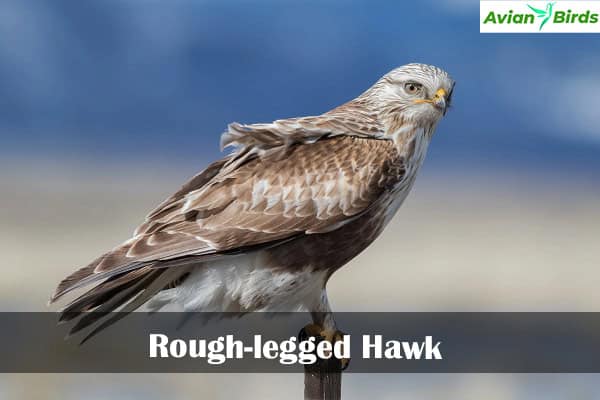
Migration Patterns
The Rough-legged Hawk moves from the Arctic to southern places like Colorado in winter. It goes where it can find food. Nonbreeding adults eat about a quarter-pound of food each day.
Nestlings need a lot of food, about 26 pounds in 40 days. This is a lot for such a small bird.
During migration, these hawks are often seen with other birds like Gyrfalcons and Peregrine Falcons. This shows they live in a diverse ecosystem. In Colorado, they are seen in many places.
| Location | Frequency (%) | Distance from Colorado Springs (miles) | Confidence Score (%) |
|---|---|---|---|
| Drennan Road | 50.0% | 50.0 | 9.5% |
| Castlewood Canyon Rd–Lake Gulch Rd | 33.3% | 33.6 | 6.1% |
| Eleven Mile State Park | 7.5% | 37.7 | N/A |
| Spinney Mountain Reservoir | 5.9% | 45.3 | N/A |
| Big Johnson Reservoir & Bluestem Prairie Open Space | 2.7% | 9.0 | N/A |
| Chatfield SP–Downstream from Kingfisher Bridge (E) | 6.2% | 49.6 | N/A |
| Bear Creek Nature Center | 3.3% | 3.1 | N/A |
| Chico Basin Ranch (Restricted Access) | 2.0% | 27.9 | N/A |
| Aurora Rampart Reservoir | 1.2% | 44.5 | N/A |
Watching these hawks helps us see why we need to protect them. We must work together to keep them in Colorado for future generations.
6. Northern Goshawk
- Scientific Name: Accipiter gentilis
- Size: 20-26 inches
- Weight: 1.5-3.3 pounds
- Lifespan: 10-15 years
- Diet: Medium-sized birds and mammals, including rabbits and squirrels
- Call: Loud, sharp “kak-kak-kak”
- Speed: 30-40 mph (up to 100 mph in a dive)
The northern goshawk is a big raptor that loves forests. It stands out because of its unique behavior. It’s big, with a length of 24 to 29 inches.
It has dark gray feathers and light gray bars on its belly. It also has a white stripe over its eyes and bright orange eyes. This makes it look very special.

Behavior in the Wild
This hawk is very good at adapting and protecting itself. It lives in big forests, especially in the northeastern United States. It builds up to eight nests in its territory.
Moreover, It eats insects, small mammals, and other birds. It flies quietly, using slow beats and short glides. It’s also very fierce when defending its nest.
The northern goshawk was split into two species in 2023. This makes it even more interesting to study. Knowing how it behaves and lives helps us protect it.
Conservation Efforts
Protecting hawks in Colorado is very important. We work hard to keep them safe. Our efforts include:
- Habitat Protection: We protect their homes and hunting spots. This keeps their numbers up.
- Public Education: We teach people why hawks are important. This helps everyone understand why we need to save them.
- Community Involvement: We get people involved in helping Hawks. This includes watching their numbers and helping with conservation.
Working together, we can protect hawks in Colorado. Joining with local birdwatchers helps us learn about conservation. We can all help save these amazing birds.
Read More🐦Related Articles:
Conclusion
Hawks in Colorado are very important for our ecosystem. They keep the balance in their homes. We see nine different kinds of hawks, like the Red-tailed hawks and the Sharp-shinned hawks.
These birds are not just beautiful; they help us understand our local world. They show us why we need to protect nature.
Watching birds helps us enjoy nature more and learn about their problems. We see how hawks face dangers like losing their homes. By helping conservation, we make sure kids can see these amazing birds, too.
We must protect their homes and support laws that help them survive. This way, we keep the skies full of life for hawks and others.
Let’s enjoy Colorado’s wildlife, especially the hawks. By working together, we can keep their homes safe. Seeing them fly makes us want to help them even more.
Frequently Asked Questions
Q1. What types of hawks are in Colorado?
Colorado is home to various hawks, including the Red-tailed Hawk, Cooper’s Hawk, and Sharp-shinned Hawk.
Q2. What is the most common bird of prey in Colorado?
The Red-tailed Hawk is the most common bird of prey in Colorado.
Q3. What is the difference between a hawk and a falcon in Colorado?
Hawks are generally larger, have broader wings, and soar more, while falcons are smaller, faster, and have pointed wings.
Q4. Are hawks protected in Colorado?
Yes, hawks are protected under federal and state laws in Colorado, including the Migratory Bird Treaty Act.
Q5. What is the rarest hawk?
The Ferruginous Hawk is considered one of the rarer hawks in North America.
Q6. What is the strongest type of hawk?
The Ferruginous Hawk is often regarded as one of the strongest hawks due to its size and hunting abilities.
Q7. What is the top predator in Colorado?
The mountain lion is considered the top predator in Colorado.



